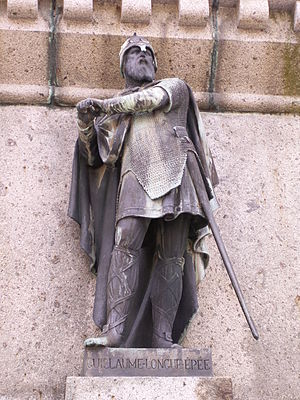William Longsword

William I Longsword(c. 900– 17 December 942) was the second "Duke of Normandy".[a]William added to his father's territories. He also began to expand NormaninfluenceinWest Francia(France).
Early career
[change|change source]William was born to theVikingRolloand his Christian wife Poppa of Bayeux.[3]He was bornoverseasprobably inEngland. [4]His mother was from aFrankishnoblefamily.[5]William wasbaptizedaChristianprobably at the same time as his father,[6]William'snicknameLongsword was probably earned during the fighting in 924–925 aroundBeauvais,PonthieuandAmiens.[6]
Duke of Normandy
[change|change source]Williamsucceededhis father asleaderin 927[7]Early in his reign he faced arebellionfrom by otherNormanswho did not think he was fit to lead them.[8]The leader of this rebellion was Riouf ofÉvreux.[8]At this same time William sent his wifeSprotatoFécampwhere their son Richard was born.[9]
In 933, William I Longsword sworeloyaltytoRaoulasKing of Western Francia.In turn Raoul gave him lordship over much of the lands of the Bretons includingAvranchesand theCotentin.[10]But theBretonsfought to keep these lands. They were led byAlan II, Duke of BrittanyandCount Berenger of Rennes.It ended shortly with Alan fleeing toEnglandand Beranger seeking to be on friendly terms with the Normans.[11]In 935, William arranged a marriage between his sister Adela andWilliam, count of Poitouwith theapprovalofHugh the Great.[12]At the same time William married Luitgarde,[13]daughter of countHerbert II of Vermandois.Herdowrygave William the lands ofLongueville,Coudresand Illiers l'Eveque.[14]

William Longsword attacked Flanders in 939 andArnulf I, Count of Flanders,andLouis IV, King of France,attacked Normandy because of this. Arnulf captured the castle ofMontreuil-sur-Merdefeating Herluin,Count of Ponthieu.Herluin helped William Longsword to take back the castle.[15]William wasexcommunicatedfor attacking and destroying lands belonging to Arnulf.[16]William pledged his loyalty to King Louis IV when they met in 940. In return for this he wasconfirmedin lands that had been given to his father, Rollo.[17]Almost three years later, on 17 December 942 atPicquignyon theSomme,William Longsword was attacked and killed by followers of Arnulf while at apeaceconferenceto settle theirdifferences.[14]
Family
[change|change source]William had one son with Sprota.[b][19]
- Richard the Fearless,who succeeded his father.[19]
William married secondly Luitgarde, daughter ofHerbert II, Count of Vermandois.[19]They had no children.[19]
Notes
[change|change source]- ↑While he is sometimes titledDuke of Normandythis is a title ofconvenienceused byhistorians.The first leaders of Normandy used the titlecountormarquis.It was not until the middle of the eleventh century until the counts of Normandy called themselves Dukes.[1]Flodoard of Reims used the termprincepswhen writing about Rollo or his son William I Longsword.[2]
- ↑After William’s death, Sprota married Esperling, a rich miller in the Pont-de-l’Arche-Louviers region. By her, he had a son, countRodulf of Ivry,who was one of the most trusted advisers of his half-brother, Richard I of Normandy.[18]
References
[change|change source]- ↑François Neveux,The Normans; The Conquests that Changed the Face of Europe,trans. Howard Curtis (London: Constable & Robinson Ltd., 2008), p. 69
- ↑The Annals of Flodoard of Reims 919–966,ed. & trans. Steven Fanning; Bernard S. Bachrach (Toronto: University of Toronto Press, 2011), p. xxi
- ↑David C. Douglas, 'Rollo of Normandy',The English Historical Review,Vol. 57, No. 228 (Oct., 1942), p. 422
- ↑François Neveux,A Brief History of the Normans,trans. Howard Curtis (London: Constable & Robbinson, Ltd, 2008), p. 62 & n. 111
- ↑François Neveux,A Brief History of the Normans,trans. Howard Curtis (London: Constable & Robbinson, Ltd, 2008), pp. 60-1
- ↑6.06.1David Crouch,The Normans: The History of a Dynasty(London: Hambledon Continuum Press, 2007), p. 9
- ↑David C. Douglas, 'Rollo of Normandy',The English Historical Review,Vol. 57, No. 228 (Oct., 1942), p. 435
- ↑8.08.1A Companion to the Anglo-Norman World,ed. Christopher Harper-Bill; Elisabeth Van Houts (Woodbridge, UK: The Boydell Press, 2007), p. 25
- ↑Eleanor Searle,Predatory Kinship and the Creation of Norman Power, 840-1066(Berkeley: University of California Press, 1988), p. 95
- ↑Pierre Riché,The Carolingians; A Family who Forged Europe,trans. Michael Idomir Allen (Philadelphia: University of Pennsylvania Press, 1993), pp. 252-3
- ↑The Gesta Normannorum Ducum of William of Jumieges, Orderic Vitalis, and Robert of Torigni,ed. & trans. Elizabeth M.C. Van Houts, Vol. I (Oxford: Clarendon Press, 1992), p. 79
- ↑The Gesta Normannorum Ducum of William of Jumieges, Orderic Vitalis, and Robert of Torigni,ed. & trans. Elizabeth M.C. Van Houts, Vol. I (Oxford: Clarendon Press, 1992), p. 81
- ↑Detlev Schwennicke,Europäische Stammtafeln: Stammtafeln zur Geschichte der Europäischen Staaten,Neue Folge, Band III Teilband 1 (Marburg, Germany: J. A. Stargardt, 1984), Tafel 79
- ↑14.014.1François Neveux,A Brief History of the Normans,trans. Howard Curtis (London: Constable & Robbinson, Ltd, 2008), p. 72
- ↑Eleanor Searle,Predatory Kinship and the Creation of Norman Power, 840-1066(Berkeley: University of California Press, 1988), p.56
- ↑The Annals of Flodoard of Reims; 916-966,ed. & trans. Steven Fanning and Bernard S. Bachrach (New York; Ontario Canada: University of Toronto Press, 2011), p. 31
- ↑The Annals of Flodoard of Reims; 916-966,ed. & trans. Steven Fanning and Bernard S. Bachrach (New York; Ontario Canada: University of Toronto Press, 2011), p. 32
- ↑Eleanor Searle,Predatory Kinship and the Creation of Norman Power, 840-1066(Berkeley: University of California Press, 1988), p. 108
- ↑19.019.119.219.3François Neveux.A Brief History of The Normans(London: Constable & Robbinson, Ltd, 2008), p. 90
